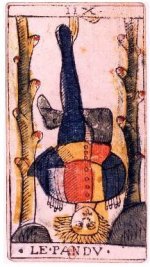jmd
This card is one of the most interesting of the deck. I say this in the sense that it is, unlike any of the others, very peculiar, and unlike any standard iconographic design found during either European mediaeval or early renaissance times.
Also, it is quite possible that early representations which copied it mis-understood it, for it has been claimed that the act of hanging a person by the foot or feet occured only in some places, and only for thieves. It is interesting, then, that Odin is one of the few myth Sagas which implies such depiction, though in that instance one representing initiation into knowledge (through which he spied the Runes).
From a Christian perspective, two 'hangings' are somewhat relevant. The first is that one of the crucified 'companions' of Christ was said to be a thief; the other is that St Peter was said to have been crucified up-side down (but upon a cross shaped like an 'X').
In each of those cases, various aspects of 'initiation' can be understood, and renunciation of that which is not one's own comes across, as well as the ability to see things from another perspective.
Attached is the (recently 'restored') 1650 Noblet version.
Also, it is quite possible that early representations which copied it mis-understood it, for it has been claimed that the act of hanging a person by the foot or feet occured only in some places, and only for thieves. It is interesting, then, that Odin is one of the few myth Sagas which implies such depiction, though in that instance one representing initiation into knowledge (through which he spied the Runes).
From a Christian perspective, two 'hangings' are somewhat relevant. The first is that one of the crucified 'companions' of Christ was said to be a thief; the other is that St Peter was said to have been crucified up-side down (but upon a cross shaped like an 'X').
In each of those cases, various aspects of 'initiation' can be understood, and renunciation of that which is not one's own comes across, as well as the ability to see things from another perspective.
Attached is the (recently 'restored') 1650 Noblet version.






